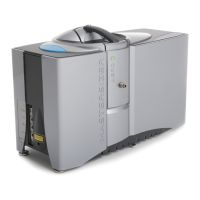Chapter 6 Sample preparation guidance
Page 6-4 MAN 0474
Considerations for dry samples
The first step when analysing a sample for the first time is to decide whether to ana-
lyse the sample in a wet or dry state. This is usually determined by the nature of the
end use of the sample. If the product is to be used and stored in a dry form, a dry
analysis may be preferred.
Some samples can only be measured in a dry state as they react with all wet disper-
sants, for example they may dissolve or the particles may swell when in contact
with a liquid.
Another consideration is whether the material in its dry state is free flowing. Good
pouring characteristics indicate a non-cohesive powder which will usually disperse
well in a dry powder feeder without any difficulties, whereas a highly cohesive
material tends to stick and clump together, giving biased measurements.
Sample clumping together can often be overcome by drying the sample in an oven.
Obviously care should be taken with delicate materials where drying in the oven
may damage the sample. To drive the moisture from the sample, set the oven to the
highest temperature possible, but not above its melting point!
If it is obvious that using an oven is going to damage the sample, use a desiccator.
A fresh sample that has not had time to absorb moisture from the atmosphere is
always preferable and usually gives better results. If hygroscopic samples need to be
conveyed to the system over some distances, they should be sealed into tubes as
soon as possible with a silica gel bag if this is practicable.
Note
Application Notes describing how to develop a method for dry sample
analysis are available at www.malvern.com.

